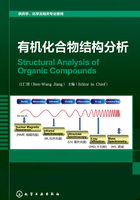
2.2 Principles of Ultraviolet and Visible Spectroscopy
In the UV spectroscopy,the spectra originate from excitation of electrons,thus it is a form of electron spectroscopy.As a molecule absorbs energy,an electron is promoted[38] from an occupied orbital[39] to an unoccupied orbital[40] of greater potential energy.Generally,the most probable transition is from the highest occupied molecular orbital (HOMO)[41]to the lowest unoccupied molecular orbital(LUMO)[42].
For most molecules,the lowest-energy occupied molecular orbitals are the σ orbitals,which correspond to σ bonds.The π orbitals lie at somewhat higher energy levels,and orbitals that hold unshared pairs[43],the nonbonding(n)orbitals[44],lie at even higher energies.The unoccupied,or antibonding orbitals(π* and σ*),are the orbitals of highest energy.Fig.2-2 shows a typical progression of electronic energy levels.

Fig.2-2 Electronic energy levels and transitions
图2-2 分子轨道电子跃迁能级图
In all compounds other than alkanes,the electrons may undergo several possible transitions[45] of different energies.Some of the most important transitions are those transitions illustrated in Figure 1.2.Of the four transitions outlined,only the two lowest energy ones are achieved by the energies available in the 200 to 800 nm spectrum.As a rule,energetically favored electron promotion will be from the HOMO to the LUMO,and the resulting species is called an excited state[46].The energy required to produce transitions from the HOMO in the ground state[47] to the lowest unoccupied energy level is less than the energy required to produce a transition from a lower occupied energy level.Thus,in Figure 1.2,an n→π*transition would have a lower energy than a π→π*transition.Not all of the transitions that at first sight appear possible are observed.Certain restrictions,called selection rules[48],must be considered.One important selection rule states the transitions that involving a change in the spin quantum number[49] of an electron during the transition are not allowed to occur; they are called “forbidden” transitions[50].Other selection rules deal with the numbers of electrons that may be excited at one time,with symmetry properties of the molecule and of the electronic states,and with other factors that need not be discussed here.Transitions that are formally forbidden by the selection rules are often not observed.However,theoretical treatments are rather approximate,and in certain cases forbidden transitions are observed,although the intensity of the absorption[51]tends to be much lower than that for transitions that are allowed by the selection rules.The n→π*transition is the most common type of forbidden transition(Pavia,et al.,Fourth Edition).
σ→σ*transitions,an electron in a σ orbital is excited to the corresponding antibonding orbital.The energy required is high.For example,methane(which has only C-H bonds,and can only undergo σ→σ*transitions)shows an absorbance maximum[52] at 125 nm.Absorption maxima due to σ→σ*transitions are not usually observed in typical UV spectra(200-700 nm).
n→σ*transitions,saturated compounds containing atoms with lone pairs(non-bonding electrons[53])are capable of n→σ*transitions.These transitions usually need less energy than σ→σ*transitions.They can be initiated by light whose wavelength is in the range of 150-250 nm.The number of organic functional groups with n→σ*peaks in the UV region is small.The atoms with unshared electron pairs should be contained.O,S,N,halogens[54].
n→π*and π→π*transitions,most absorption spectroscopy of organic compounds is based on transitions of n or π electrons to the π*excited state,are observed in compounds with lone pairs and multiple bonds in typical UV spectra(200-600 nm).These transitions fall in an experimentally convenient region of the spectra(200-700 nm).These transitions need an unsaturated group[55] in the molecule to provide the π electrons.